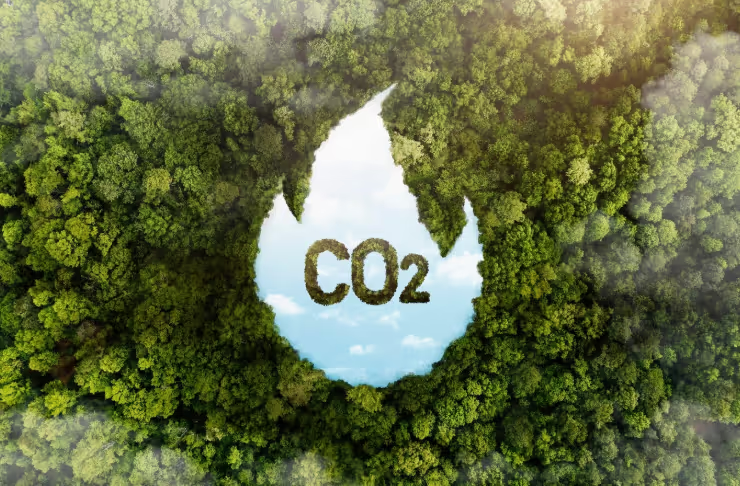Stay informed with our newsletter.
.webp)

.webp)

This header refers to the historical overview of global annual carbon dioxide (CO₂) emissions spanning from 1940 to 2024. The data likely illustrates how industrial growth, population increases, and energy consumption have contributed to rising emissions over the decades. Key events such as wars, economic booms, environmental regulations, and global climate agreements would have impacted these emission trends. Understanding this timeline helps contextualize today’s climate challenges and the urgent need for sustainable energy solutions and emission reduction efforts.

In 2023, carbon dioxide emissions from the burning of fossil fuels and industrial activities reached approximately 37.01 billion metric tons globally. This figure marks a continuation of a long-term upward trend. By 2024, emissions are expected to climb further by around 1.08%, reaching an all-time high of about 37.41 billion metric tons of CO₂. This steady increase highlights the persistent reliance on fossil fuels despite growing awareness of the climate crisis. Since the year 1990, global carbon dioxide emissions have surged by over 60%, underlining how emissions have continued to grow even in the face of international climate agreements and increasing technological advancements.
A major factor driving this rise is the contribution of a few key nations to the overall volume of greenhouse gases released into the atmosphere. Among all countries, China currently emits the most carbon dioxide, with the United States following closely behind. This wasn't always the case. China’s emissions have skyrocketed over the past three decades, largely due to its rapid industrial development and expansion in manufacturing. Since 1990, China's CO₂ emissions have risen by nearly 450%, a staggering increase fueled by urbanization, coal dependency, and a growing middle class. In contrast, the United States has managed to reduce its emissions by around 6.1% during the same time period, due to cleaner technologies, a shift from coal to natural gas, and evolving environmental policies. Despite this progress, the U.S. still holds the distinction of being the largest historical emitter of carbon dioxide, having released more CO₂ into the atmosphere over time than any other nation.
Though emissions generally rise year after year, major global events have occasionally interrupted this trend. One of the most significant recent examples occurred in 2020 during the COVID-19 pandemic. As countries around the world enforced lockdowns, restricted travel, and limited industrial operations, global carbon dioxide emissions fell by approximately 5.5%. This dramatic drop was the largest single-year decrease in decades and offered a rare glimpse into what lower emissions levels could look like. However, the reduction was temporary. As economies began to recover and restrictions eased, emissions quickly rebounded.
This pattern of emissions falling during global disruptions isn't unique to the pandemic. In 2009, following the global financial crisis, emissions dipped by nearly two percent due to a slowdown in industrial output and energy consumption. Similarly, the early 1980s recession had a noticeable impact on emissions as economic activity contracted worldwide. The most significant annual decline in carbon dioxide emissions in modern history occurred in 1945, at the end of World War II, when emissions dropped by approximately 17%. This dramatic reduction was a direct result of the massive disruption caused by the war, including reduced manufacturing, fuel shortages, and large-scale destruction across Europe and Asia.
These historical examples reveal how closely tied emissions are to global economic activity. When economies slow down, whether due to financial crises, pandemics, or conflicts, energy demand and emissions typically decline. Yet, once recovery begins, emissions often return to or surpass previous levels unless structural changes are made. These cycles show the importance of decoupling economic growth from carbon emissions. Without this shift, emissions are likely to continue increasing with each recovery phase, pushing climate goals further out of reach.
Addressing carbon emissions effectively requires both immediate action and long-term strategies. Transitioning to renewable energy sources such as solar, wind, and hydroelectric power can play a significant role in reducing the world’s dependence on fossil fuels. Simultaneously, efforts to improve energy efficiency in buildings, transportation, and industry are essential. Investment in green technologies, carbon capture solutions, and international cooperation are also crucial components of a comprehensive climate strategy.
Another key consideration is climate justice. While developing countries like China are now the largest emitters on an annual basis, much of the accumulated carbon dioxide in the atmosphere has been emitted by industrialized nations over the past century. These countries, having already reaped the economic benefits of carbon-intensive growth, bear a larger responsibility for driving global warming and have more resources to invest in solutions. As such, many climate agreements include provisions for developed nations to support mitigation and adaptation efforts in the Global South.
In conclusion, carbon dioxide emissions from fossil fuels and industry continue to rise, driven by industrial growth, energy demand, and an ongoing reliance on fossil fuels. While global events such as pandemics and economic downturns have periodically caused emissions to fall, these reductions are often short-lived and tied to hardship rather than deliberate climate action. The challenge lies in breaking the link between emissions and economic activity, creating a path to prosperity that does not rely on pollution. Through bold leadership, international cooperation, and a commitment to sustainability, it is still possible to change course and build a cleaner, more resilient future.
For questions or comments write to contactus@bostonbrandmedia.com
Source: statista
